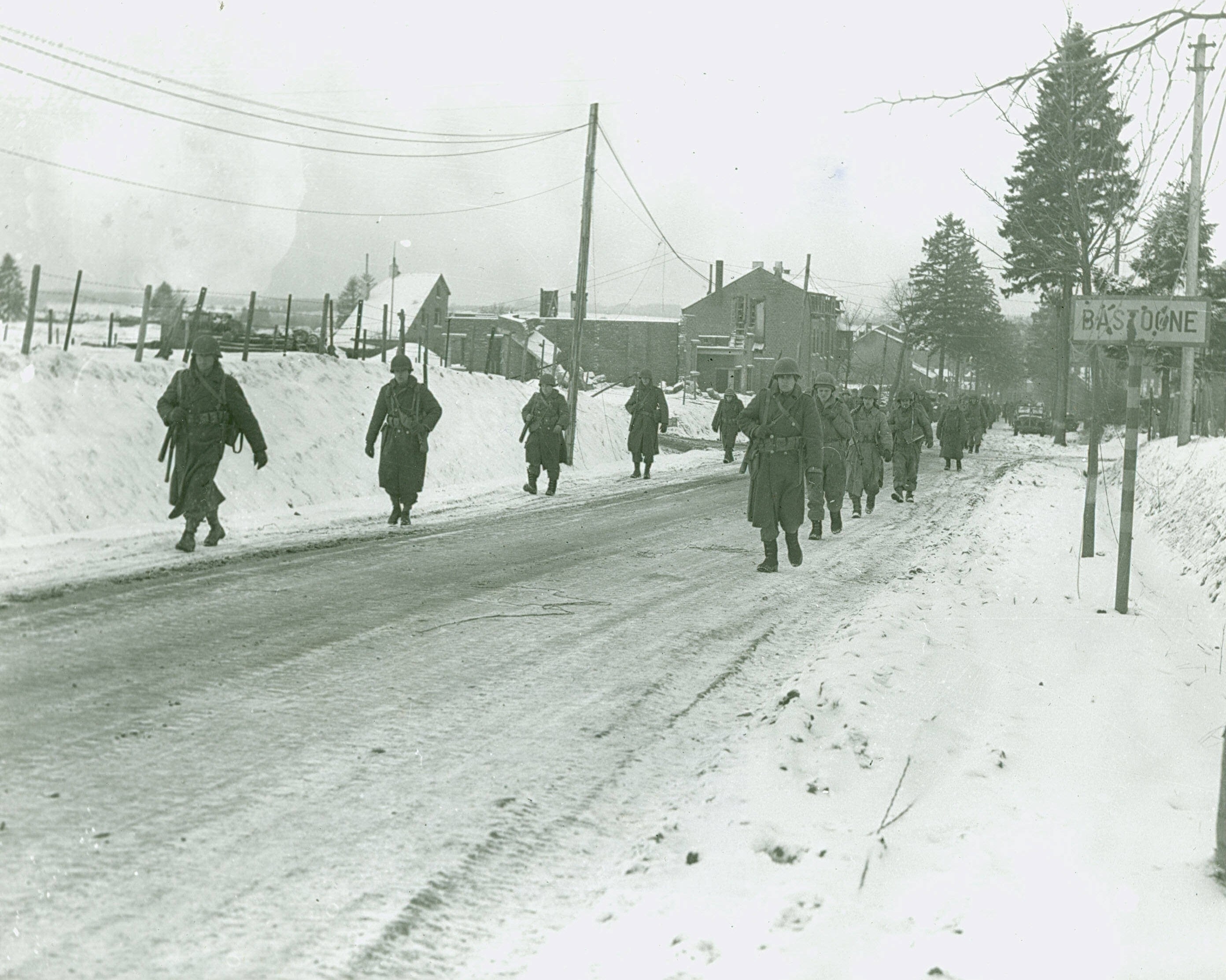On December 16, 1944, Hitler launched his last great offensive on the Western Front through the Ardennes. Known as the Battle of the Bulge because of the wedge driven into the Allied lines, the campaign lasted for approximately five weeks, and it is generally agreed that the offensive officially ended on January 25, 1945.
Hitler's initial plan was to launch a counter-offensive in the west in hopes of splitting the British and American lines and capturing the port of Antwerp with its vast stores of Allied military supplies, enough to re-equip the German's own dwindling stocks. The code name for the operation, Wacht Am Rhein (Watch on the Rhine), was known to only a few high ranking officers in the German army.
In order to carry out the offensive, new levies of manpower were called up. By late 1944, the cream of the German army had been wasted on the Russian steppes after three years of bitter fighting against the Soviet Red Army. Yet, amazingly, the Germans were able to scratch together approximately 28 divisions for the upcoming offensive. These divisions consisted of some veteran divisions pulled from other fronts and newly created divisions called Volksgrenadier (People Grenadier) divisions, which were hastily trained and poorly equipped. To spearhead the invasion, the Sixth SS Panzer Army, commanded by SS Oberstgruppenfuhrer (General) Josef Dietrich, one of Hitler's oldest and staunchest supporters, was selected.
Within the Sixth SS Panzer Army was a unit called Kampfgruppe Peiper (Battlegroup Peiper) named after its commander, SS Standartenfuhrer (Colonel) Joachim Peiper, Heinrich Himmler's former adjutant, and a veteran of the tough fighting in the east. This unit would play a key role in the initial onslaught. Another unit, commanded by SS Obersturmbannfuhrer (Lieutenant Colonel) Otto Skorzeny, consisted of English-speaking Germans who caused havoc, fear and distrust behind American lines. With these forces, then, Hitler hoped to smash the Allied armies in the West, secure a separate peace, and then turn and finish off the approaching Red Army, which was already in Poland.
The campaign got off to a good start, with the Germans catching U.S. forces completely by surprise. In the ensuing weeks, some 10,000 American prisoners would be taken, the largest surrender of U.S. forces since Bataan in the Philippines, some two and a half years earlier. Additionally, inclement weather grounded most U.S. airpower, permitting German armor forces and convoys to travel at will without the threat of being attacked.
The Germans also attacked through an area, the Ardennes, which was considered a "quiet sector" of the front, and where it was erroneously believed that German armor could not operate. Many in the west failed to remember that the Germans had successfully used this same route in their May 1940 campaign against the Low Countries and France. After the first few days on the offensive, the Germans, who were attempting to stick to a timetable, began to run into mounting resistance from American forces, particularly at the important crossroad juncture at Bastogne, Belgium. There, the Germans had surrounded the 101st Airborne Division, which successfully held off repeated attacks by the Germans. When asked by German emissaries to surrender, the acting 101st commander, Brigadier General Tony McAuliffe replied, "Nuts."
On December 26, 1944, LTG George S. Patton, 3rd Army, arrived at Bastogne and relieved the garrison. By late December, the skies cleared, allowing American airpower to again take the fight to the enemy. German vehicles, particularly their armor, began running out of fuel, as many of the Allied fuel dumps that they had hoped to capture intact were destroyed by the fleeing Americans.
On January 1, 1945, the last great sortie by the German Luftwaffe took place during Operation Bodenplatte. Close to 1,000 German aircraft were assembled for this raid, which concentrated on attacking Allied airfields in France and the Low Countries, and succeeded in destroying well over a hundred Allied aircraft on the ground. However, the losses incurred by the Luftwaffe during the raid were irreplaceable, whereas the Allies made up their losses quickly. By January 25, 1945, the German lines had been pushed back to their initial jumping off point. Hitler's last gamble in the West had ended in failure. The Germans lost approximately 100,000 men, who could not be replaced, while Allied casualties were placed at about 80,000, killed, wounded, and captured. The Third Reich was now in its death throes, and it was only a matter of months before it totally collapsed from the Allied onslaught.
Editor's Note: Colonel John Dabrowski is a Civil Affairs officer and military historian. In 2008, he was assigned to the U.S. Army Heritage and Education Center. He currently serves on the staff of the Strategic Studies Institute of the U.S. Army War College. He holds a doctorate in History from Kent State University.


Social Sharing